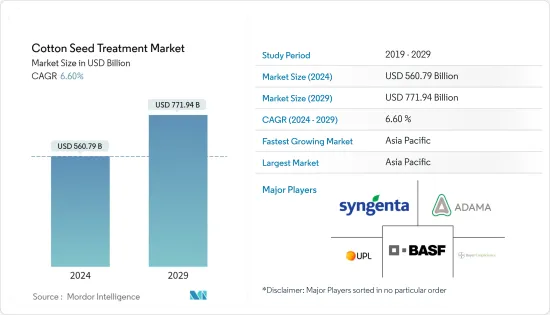
면실 처리 시장 규모는 2024년 5,607억 9,000만 달러로 추정되며 2029년까지 7,719억 4,000만 달러에 달할 것으로 예상되며, 예측 기간(2024-2029년) 동안 6.60%의 CAGR로 성장할 것으로 예상됩니다.

면화 초기 단계의 곰팡이병은 종자 처리를 통해 쉽게 방제할 수 있습니다. 초기 단계의 목화에서 방제할 수 있는 주요 곰팡이 병원균에는 푸사리움, 리조크토니아, 헬민트스포리움, 피시움, 피토프트라, 티에라비옵시스 등이 있습니다. 곤충은 면화 작물에 가장 큰 피해를 주는 해충이지만, 작물 초기 단계의 곰팡이 병은 종자 처리를 통해 더 효과적으로 제어할 수 있는 것으로 나타났습니다. 면화 종자 처리에 사용되는 가장 일반적인 살균제에는 아족시스트로빈, 디페노코나졸, 플루디옥소닐, 메탈락실, 마이크로부타닐 등이 있습니다. 이러한 살균제는 주로 여러 병원균을 광범위하게 제어하기 위해 조합하여 사용됩니다. 살균 종자 처리 제품의 효능이 향상됨에 따라 면화 종자 처리 시장의 살균제 부문이 시장을 주도할 것으로 예상됩니다.
인도, 중국, 파키스탄은 아시아태평양에서 대부분의 면화를 재배하는 국가입니다. 인도는 1,220만 헥타르 이상의 면화를 재배하고 있습니다. 2014년까지 인도는 유전자 변형 면화 보급률이 92%에 달했습니다. 이로써 인도는 세계 최대의 면화 생산국이자 원면 수출국이 되었습니다. GM 면화의 채택은 또한 면화 상업용 종자 가공 분야가 검토 기간 동안 엄청난 성장을 이루었음을 의미합니다. 아시아태평양 시장은 대규모 다국적 기업뿐만 아니라 시장에서 활동하는 소규모 지역 기업의 존재가 특징입니다. 이 지역 시장의 상업적 분야에서 활동하는 기업들은 작물의 첫 15-20일 동안 목화에 기생하는 거의 모든 병원균과 해충을 광범위하게 방제할 수 있는 제품 조합을 종자 회사에 제공하는 데 점점 더 중점을 두고 있습니다.
면실 처리 시장은 고도로 통합되어 있으며, 세계 주요 기업들이 시장 점유율을 크게 차지하고 있습니다. 이들 기업의 시장 점유율 확대는 고도로 다각화된 제품 포트폴리오와 다수의 인수 및 계약에 기인하는 것으로 보입니다. 또한, 이들 기업은 연구개발, 제품 포트폴리오 확장, 광범위한 지리적 입지, 적극적인 인수 전략에 집중하고 있습니다. 주요 기업으로는 BASF SE, Syngenta AG, Adama Agriculture Solutions, UPL Limited, Bayer Crop Science AG 등이 있습니다.
The Cotton Seed Treatment Market size is estimated at USD 560.79 billion in 2024, and is expected to reach USD 771.94 billion by 2029, growing at a CAGR of 6.60% during the forecast period (2024-2029).

Early-stage fungal diseases in cotton can easily be controlled using seed treatment. The major fungal pathogens that can be controlled in early-stage cotton include Fusarium, Rhizoctonia, Helminthosporium, Pythium, Phytophthora, and Thielaviopsis. Although insects are the most damaging pests to cotton crop, fungal diseases at the early stages of the crop have found greater control through seed treatment. Some of the most popular fungicides used in the seed treatment of cotton are Azoxystrobin, Difenoconazole, Fludioxonil, Metalaxyl, and Myclobutanil, among others. These fungicides are used mostly in combinations to provide broad-spectrum control to more than one pathogen. The increased efficacy of fungicidal seed treatment products is expected to drive the market for the fungicide segment of the cotton seed treatment market.
India, China, and Pakistan are the countries that cultivate a majority of cotton in the Asia-Pacific region. Cotton is grown over 12.2 million hectares in India. By the year 2014, India had achieved almost 92% penetration of genetically modified cotton. This has led to India being the top cotton producer and raw cotton exporter in the world. The adoption of GM cotton also means that the segment of commercial seed treatment in cotton has grown phenomenally over the review period. The Asia-Pacific market is characterized by the presence of large multinationals as well as smaller regional players active in the market. Companies active in the commercial segment of the market in the region are increasingly focusing on providing seed companies with product combinations, which provide broad spectrum control to almost all the pathogens and pests that infest cotton for the first 15-20 days of the crop.
The cotton seed treatment market is highly consolidated, with the top global players occupying large shares in the market. The greater market shares of these players can be attributed to highly diversified product portfolio and numerous acquisitions and agreements. Moreover, these players are focusing on R&D, expansion of product portfolio, wide geographical presence, and aggressive acquisition strategies. Some of the key players in the market include BASF SE, Syngenta AG, Adama Agricultural Solutions, UPL Limited, and Bayer Crop Science AG.